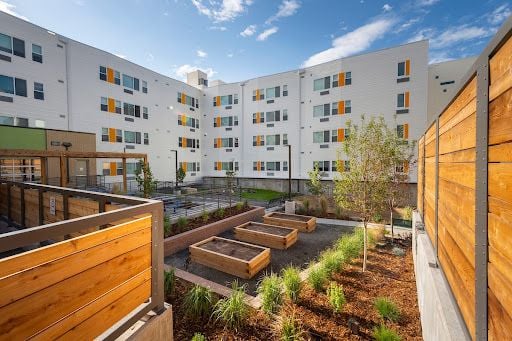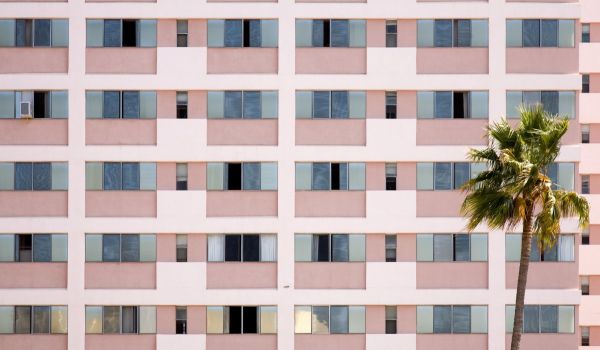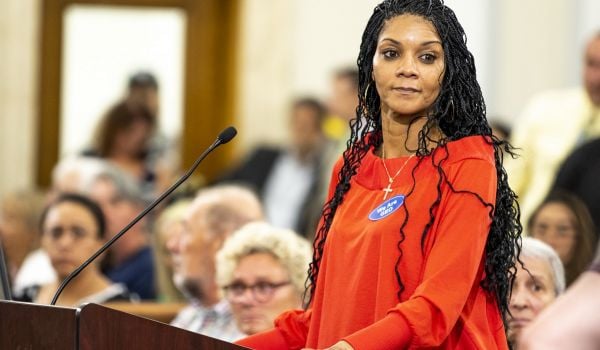For many of us, the global lockdowns stemming from the COVID-19 pandemic have made our homes places of respite, healing, and renewal. But for many others, including the unhoused, “home” is not always healing and can in fact be just the opposite.
Shari Stratton knows that all too well. For her, “home” meant a constant threat of domestic violence. When she eventually left, she had nowhere to turn until she found Arroyo Village, a supportive housing complex designed for those with traumatic histories. In a written profile she said she had stayed with friends and had applied for a shelter but instead was provided an apartment in Arroyo Village. She had worried that apartment living would be loud, a trigger for her PTSD, but that hasn’t been a problem for her.
“The apartments are really soundproof and it’s a secure, safe place to live,” she wrote. They were soundproofed by design in fact. The growing awareness of the impact of the built environment on our health is one reason for the growth of trauma-informed design — design that includes adaptations to support a strengths-based framework based in an understanding of, and responsiveness to, the impact of trauma.
Sandra Serna, vice-president health and housing at Stewards of Affordable Housing for the Future (SAHF), said that the COVID-19 pandemic put a spotlight on the importance of home as a safe and health-protecting haven.
“Substandard housing — places that are overcrowded, dark, confining, poorly ventilated, or without access to social support — really highlight the negative impact poor-quality indoor environments can have on health,” she added.
Chad Holtzinger, president of the Denver-based architecture firm Shopworks Architecture, sees this connection of housing to physical and mental health in his daily work. “Places don’t feel great and you know why: they’re dark; they’re not connected to the environment; and they don’t have a lot of options for living. It looks great from the outside, but when you walk in, the space looks gross and you can’t put your finger on what’s wrong. We’re trying to put our finger on it by saying: ‘Here are those spaces that promote feelings of well-being and connection to the environment, that speak to the quality of life.’”
Denver’s Arroyo Village, a 60-bed homeless shelter that also includes 35 units of low-income permanent supportive housing and 95 units of affordable housing for individuals and families, is one of those spaces.
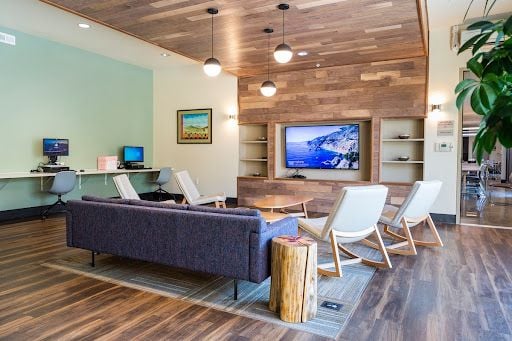
(Photo courtesy Arroyo Village)
Stephanie Miller, CEO of the Delores Project, which manages Arroyo Village in partnership with Rocky Mountain Communities, said that in Denver, the pandemic has brought seven to eight other shelters together to help open auxiliary shelters. Moreover, the city’s push to incorporate trauma-informed design principles has begun to change how spaces are considered.
“We used to be one of the few shelters in Denver that was trauma-informed, but the pandemic has helped shift the culture, the mindset, and the innovation frameworks to intentional, housing-first, strength-based interventions that give as much choice and autonomy to individuals,” Miller said. She added that the city is investing in 13 affordable housing projects in its development pipeline, which will produce 1,021 units of affordable housing, including a 75-bed medical respite community.
Whose Trauma Gets Addressed?
Trauma-informed practices have been, and remain, firmly rooted in design, although Black, Brown, and Indigenous people have not historically benefited from the practice.
The murders of George Floyd and Breonna Taylor, and the health disparities highlighted by the COVID-19 pandemic, have shown the degree to which race-based violence and discrimination underpin U.S. policy. This discrimination has been mirrored in housing policies, including redlining, that continue to have traumatic effects on people of color.
“In so many ways trauma-informed approaches have been for the benefit of a particular class or focus, situated in power,” said Abdul-Qadir Islam, a scholar at Columbia University’s Teachers College. “In the broader scheme, as we think about people learning, and how people engage with the spaces in the world around them, much of it is centered around the white upper class that have access to resources to address their trauma.”
Researchers Lillian Comas-Diaz, Gordon Nagayama Hall, and Helen Neville have determined that the symptoms of racial trauma, such as fatigue, lack of focus, hypervigilance, avoidance, suspiciousness, headaches, and heart palpitations, are among those clinically outlined for diagnosing Post-Traumatic Stress Disorder (PTSD). But unlike PTSD, which is linked to a particular experience or series of experiences, racial trauma is marked by continuous direct and indirect exposure to race-based stress, which has a traumatic effect on society as a whole.
Holtzinger, whose firm Shopworks Architecture designed Arroyo Village, said that the organization’s work has been informed by training that shows a link between adverse childhood experiences (ACE) and brain development. He added that as a result, Shopworks began thinking about ways the built environment can be welcoming, feel safe, and help with the repair and healing of the brain and the prefrontal cortex.
Designing for Trauma
That consideration, according to Miller, was key in creating trauma-informed spaces at Arroyo Village.
One trauma-informed consideration is the stairways. Having substantial lighting, cut-out windows, and corridors that are larger than normal highlight interrelationships that enable people to feel comfortable and safe in a building at any time, Miller said.

Shopworks Architects designed a light and airy room for Providence at the Heights, an apartment in Aurora, Colo. run by Second Chance Center with 50 one and two-bedroom supportive housing apartments. The building is designed to support individuals exiting incarceration and features a ground-level amenity area including leasing and case management offices, gathering areas, a courtyard, and other flexible spaces for various programming needs. (Photo courtesy Shopworks)
“Trauma-informed design for any community would have to look at the space and environment, as well as the structural design and space in terms of landscaping, such as the addition of exterior fences and light fixtures. You can translate that to the community making sure there’s enough open space and choices in space for residents.”
Serna also noted that the Sanderson Apartments in Denver, which opened in 2017, have provided developers and property managers with a model for implementing trauma-informed practices in affordable housing. For the design, Davis Partnership Architects, in collaboration with the Mental Health Center of Denver, sought to include design principles beneficial to health and well-being, including elements such as green space and natural light, Serna said.
“A lot of work went into making sure there were design elements that facilitated safety and belonging,” she said. “Some residents have said: ‘This is the first space I’ve been in that’s felt safe and welcoming.’”
Serna said that including residents’ needs and ideas in the design sends the message that “This is for you: This is your home.” She added that, while such examples are anecdotal, the benefits a thoughtful, well-designed space can have can’t be underestimated.”
Quality of life has become all the more important in the wake of COVID-19. As Black, Brown, and Indigenous people in the U.S. increasingly question and criticize systems that support inequality — including the criminal justice and financial systems — there are some who maintain that the institutionalization of trauma-informed principles is necessary to address rapidly shifting demographics.
“Many corporations, industries, and other stakeholders are now interested in trauma-informed principles and redress for larger swaths of the population, because the majority of that population is now turning racially and culturally diverse in ways that power holders now have to address in order to continue to hold power,” Islam said. “People are saying enough is enough.”
The Way Forward: Residents’ Voices
The key to implementing trauma-informed design practices in community development, and expanding them to heal communities, is talking to residents.
CommonBond Communities, a member of Stewards of Affordable Housing for the Future, hired a behavioral consultant to work with staff and residents to determine where they feel comfortable talking about their experiences and how they continue to be shaped by them. CommonBond did this with the understanding that mental wellness is a priority for residents and staff. Moreover, Holtzinger says, the experiences of people who have not been housed must be paramount in creating spaces that are conducive to healing.
At the same time, Islam noted that such conversations need to be expanded dramatically in order to redress white supremacy.
“In the U.S. system, there exist noticeable traumas toward marginalized bodies over generations. If that trauma is to be informed, we have to listen to each other,” Islam said. “The systems that are operating in this country now are not listening to trauma-informed practices because they don’t accept that trauma is significant enough to affect their lives, or those of marginalized people.”
Serna noted that including residents in the design of the space sends a message that it is a home in which every resident has a stake. She added that, beyond just a roof, the building is also a hub to connect residents to other things that help them to thrive. The effort to connect residents and help form a larger, interrelated community beyond a particular development has led to the exploration of ways in which people can begin to address their trauma collectively and heal.
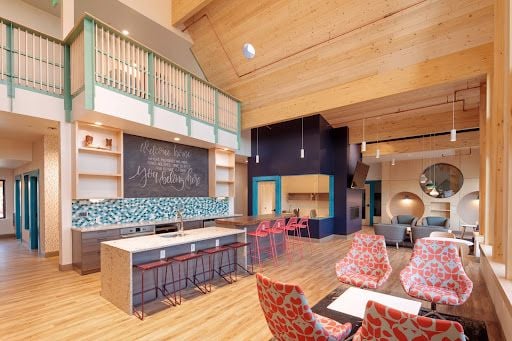
Lounge area at Laurel House, a trauma-informed supportive housing apartment for youth who have experienced homelessness. The building has ample indoor and outdoor amenity space to ensure the youth have various places to gather and connect. (Photo courtesy Shopworks)
While the human resources cost represents the single biggest vulnerability to a building, according to Holtzinger, that barrier is not insurmountable so long as people can communicate with each other.
“With some simple refinements and an acknowledgment of a reframing of priorities, those costs can fall because the relationship between staff and residents has been stabilized,” he said. “The environment is inherently safe, and harmful behaviors are discouraged.”
Islam has maintained that it is imperative that Black, Brown, and Indigenous people realize that they have power, and that agency is connected to power in the community. A welcoming space designed to acknowledge and address ongoing racial trauma, can empower communities and provide a context for newcomers, so they can begin to understand the communities they enter.
Having endured the COVID-19 lockdowns, and now, mutating strains of the virus, the principles inherent in trauma-informed design — safety, acceptance, and empathy — have an added resonance. The fear and uncertainty caused by the pandemic is universal, and our collective need to address that, and other traumas, is undeniable. But, if there’s any lesson that can be taken from the events of the last 18 months, it is that spaces that welcome us and affirm our shared experiences are as vital for healing as any medicine.
This story was published with the permission of Build Healthy Places Network; it appears in Crosswalk, a gathering place for stories that illustrate the deep connection between health and place. We’ve updated this piece to clarify that CommonBond Communities is the group that hired the behavioral consultant.
Carl Winfield is a sustainability editor and journalist based in New York City.

